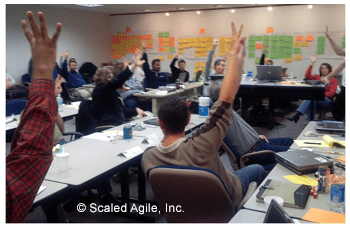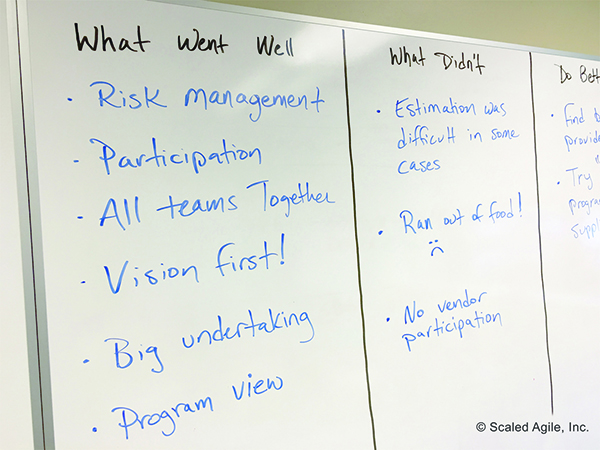It+schedule and Facilitate Review Meetings of Various Deliverables for Releases/projects
![]()
Future product development tasks can't be predetermined. Distribute planning and control to those who can understand and react to the terminate results.
—Michael Kennedy, Production Development for the Lean Enterprise
There is no magic in Rubber . . . except perchance for PI Planning.
—Authors
PI Planning
Introduction to PI Planning: A Quick Overview

Plan Increment (PI) Planning is a cadence-based, face-to-face event that serves every bit the heartbeat of the Agile Release Train (ART), aligning all the teams on the ART to a shared mission and Vision.
PI planning is essential to SAFe: If you are not doing it, you lot are non doing SAFe.
Details
Find a Class:
Implementing Rubber
Leading Safe
Rubber for Teams
Safe Scrum Master
SAFe Advanced Scrum Master
Safe Product Owner / Product Director
Rubber Release Train Engineer
SAFe DevOps

The Active Manifesto states, "The most efficient and effective method of conveying data to and inside a development squad is a face-to-face conversation." SAFe takes this to the next level with PI planning.
Where possible this involves concrete collocation, and these large calibration PI planning events now take place within many enterprises around the globe. They accept clearly shown real financial ROI, non to mention the intangibles that occur when the team of Agile teams creates a social construct that is personally and collectively rewarding.
It may not ever be practical for the unabridged Agile Release Train (ART) to collocate still, and in our current times COVID-19 has created a situation where this isn't an choice. While physical face up to confront planning has its benefits, the unwritten Prophylactic 'rule' is "the people who exercise the work programme the work." When physical presence is not possible, real time, concurrent, virtual, face up to face planning has now proven to be effective. Indeed many ARTs accept been successful in creating a hybrid situation where several teams join remotely, every bit shown below in Figure 1.
The advanced topic article, Distributed PI Planning with SAFe, provides additional guidance and considerations for successfully managing these scenarios.

PI Planning has a standard calendar that includes a presentation of business context and vision, followed by team planning breakouts—where the teams create their Iteration plans and objectives for the upcoming Program Increment (PI). Facilitated by the Release Train Engineer (RTE), this upshot includes all members of the ART and occurs inside the Innovation and Planning (IP) Iteration. Holding the event during the IP iteration avoids affecting the scheduling, or capacity of other iterations in the PI. PI Planning takes place over ii days, although this is often extended to suit planning across multiple time zones.
Business Benefits of PI Planning
PI planning delivers many business benefits, including:
- Establishing contiguous advice across all squad members and stakeholders
- Building the social network the Art depends upon
- Adjustment development to business goals with the business organisation context, vision, and Team and Program PI objectives
- Identifying dependencies and fostering cross-team and cantankerous-ART collaboration
- Providing the opportunity for 'just the right amount' of architecture and Lean User Experience (UX) guidance
- Matching demand to chapters and eliminating excess Work in Process (WIP)
- Fast decision-making
Inputs and Outputs of PI Planning
Inputs to PI planning include:
- Business context (come across 'content readiness' beneath)
- Roadmap and vision
- Superlative 10 Features of the Program Backlog
A successful PI planning event delivers two primary outputs:
- Committed PI objectives – A ready of SMART objectives that are created past each team with the business value assigned by the Business Owners.
- Plan lath – Highlighting the new feature delivery dates, feature dependencies among teams and relevant Milestones.
Grooming
PI planning is a significant event that requires grooming, coordination, and communication. It is facilitated by the RTE and result attendees include Business Owners, Production Management, Agile Teams, Arrangement and Solution Architects/Applied science, the Arrangement Team, and other stakeholders, all of whom must be notified in advance to exist well prepared. The active participation of Business organisation Owners in this event provides an of import Guardrail on budgetary spend.
For the event to be successful, preparation is required in 3 major areas:
- Organizational readiness – Strategic alignment and teams and trains setup
- Content readiness – Direction and evolution preparedness
- Logistics readiness – Considerations for running a successful event
Beneath are highlights of the Art Readiness Checklist. (The full checklist is provided in the SAFe PI Planning Toolkit, available to SPCs).
Organizational Readiness
Before PI planning, there must be strategy alignment amid participants, stakeholders, and Business Owners. Disquisitional roles are assigned. To address this in advance, notwithstanding, outcome organizers must consider the following:
- Planning scope and context – Is the scope (product, organisation, engineering science domain) of the planning process understood? Exercise we know which teams need to plan together?
- Concern alignment – Is there reasonable agreement on priorities among the Concern Owners?
- Agile teams – Do we have Agile teams? Are in that location dedicated squad members and an identified Scrum Primary and Production Owner for each team?
Content Readiness
It'southward equally of import to ensure that in that location is a clear vision and context and that the correct stakeholders can participate. Therefore, the PI planning must include:
- Executive briefing – A briefing that defines the current business context
- Production vision briefing(s) – Briefings prepared by Production Management, including the tiptop 10 features in the Program Backlog
- Architecture vision briefing – A presentation made by the CTO, Enterprise Builder, or Organization Builder to communicate new Enablers, features, and Nonfunctional Requirements (NFRs)
Logistics Readiness
Preparing an event to support a big number of attendees isn't piddling. For physically collocated planning this can include securing and preparing the physical space. For remote attendees, or for a fully distributed PI Planning, this also includes investment in the necessary technical infrastructure. Considerations include:
- Locations – Each planning location must be prepared in accelerate
- Technology and tooling – Real-time access to data and tooling to back up distributed planning or remote attendees
- Communication channels – Primary and secondary audio, video, and presentation channels must exist bachelor
Standard Agenda
The outcome follows an agenda similar to Figure two. Descriptions of each item follow. For guidance on adapting this agenda to back up planning across multiple time zones, refer to the avant-garde topic commodity, Distributed PI Planning with Rubber.

Twenty-four hours 1 Calendar
- Business concern context – A Business Owner or senior executive describes the current state of the business, shares the Portfolio Vision, and presents a perspective on how effectively existing solutions are addressing current customer needs.
- Product/solution vision – Production Management presents the current vision (typically represented past the adjacent peak 10 upcoming features) and highlights whatsoever changes from the previous PI planning issue, equally well as any forthcoming Milestones.
- Compages vision and development practices – System Builder/Applied science presents the compages vision. Too, a senior development managing director may innovate Agile-supportive changes to development practices, such as exam automation, DevOps, Continuous Integration, and Continuous Deployment, which are existence advanced in the upcoming PI.
- Planning context and lunch – The RTE presents the planning process and expected outcomes.
- Team breakouts #one – In the breakout, teams estimate their capacity for each Iteration and identify the excess items they volition probable need to realize the features. Each team creates their typhoon plans, visible to all, iteration by iteration.
During this procedure, teams identify risks and dependencies and draft their initial team PI objectives. The PI objectives typically include 'uncommitted objectives,' which are goals congenital into the plan (e.g., stories that have been defined and included for these objectives), but are non committed to by the team considering of likewise many unknowns or risks. Uncommitted objectives are not extra things to do in case there is fourth dimension. Instead, they increase the reliability of the plan and give management an early warning of goals that the Fine art may non be able to deliver. The teams also add the features and associated dependencies to the program board, as shown in Figure 3.

- Draft plan review – During the tightly timeboxed draft programme review, teams present key planning outputs, which include chapters and load, draft PI objectives, potential risks, and dependencies. Business Owners, Product Management, and other teams and stakeholders review and provide input.
- Direction review and problem-solving – It's likely that the draft plans nowadays challenges such as scope, people and resource constraints, and dependencies. During the problem-solving coming together, management may negotiate scope changes and resolve other bug by agreeing to diverse planning adjustments. The RTE facilitates and keeps the primary stakeholders together for as long as necessary to brand the decisions needed to achieve doable objectives.
In multi-ART Solution Trains, a similar consequence may be held after the first solar day of planning to resolve cross-Art issues that have come up up. Alternatively, the RTEs of the involved trains may talk with each other to raise issues that are then resolved in each Fine art'due south specific management review and problem-solving meeting. The Solution Train Engineer (STE) helps facilitate and resolve issues across the ARTs.
Day 2 Agenda
- Planning adjustments – The next solar day, the event begins with management presenting any changes to planning scope, people, and resources.
- Team breakouts #2 – Teams go along planning based on their agenda from the previous twenty-four hours, making the appropriate adjustments. They finalize their objectives for the PI, to which the Business organisation Owners assign business organization value, as shown in Effigy four.

Effigy 4. A team'due south PI objectives sheet with assigned business value - Final plan review and lunch – During this session, all teams nowadays their plans to the group. At the end of each team'southward time slot, the team states their risks and impediments and provides the risks to the RTE for use later in the ROAMing do. The team and so asks the Business concern Owners if the plan is acceptable. If the program is accepted the team brings their team PI objective sheet to the forepart of the room then everyone can run across the aggregate objectives unfold in existent-time. If the Business organisation Owners take concerns, teams are given the opportunity to adjust the programme as needed to accost the issues identified. The team and so presents their revised programme.
- Programme risks – During planning, teams accept identified program risks and impediments that could impact their ability to meet their objectives. These are resolved in a broader direction context in forepart of the whole train. One by 1, the risks are discussed and addressed with honesty and transparency, and so categorized into one of the following categories:
- Resolved – The teams hold that the risk is no longer a concern.
- Owned – Someone on the train takes ownership of the risk since it cannot be resolved during PI planning.
- Accepted – Some risks are just facts or potential problems that must be understood and accepted.
- Mitigated – Teams identify a plan to reduce the affect of the risk.
- Confidence vote – Once program risks have been addressed, teams vote on their conviction in meeting their team PI objectives.
Each team conducts a 'fist of five' vote. If the average is iii fingers or to a higher place, then management should accept the commitment. If it's less than iii, the team reworks the programme. Whatever person voting 2 fingers or fewer should exist given an opportunity to voice their concerns. This might add together to the listing of risks, require some re-planning, or just be informative. Once each team has voted the procedure is repeated for the unabridged Art with everyone expressing their confidence in the collective plan, as illustrated in Figure 5.

- Programme rework – If necessary, teams rework their plans until a high conviction level can be reached. This is ane occasion where alignment and commitment are valued more highly than adhering to a timebox.
- Planning retrospective and moving forward – Finally, the RTE leads a brief retrospective for the PI planning outcome to capture what went well, what didn't, and what can be done ameliorate next time, as shown in Effigy 6.

- Typically a word about the adjacent steps, along with final instructions to the teams, follows. This might include:
- Cleaning up the rooms used for planning.
- Capturing the team PI objectives and stories in an Active project management tool.
- Reviewing team and ART events calendars.
- Determining Iteration Planning and daily stand-up (DSU) locations and timings.
Later the planning event is washed, the RTE and other Art stakeholders summarize the private squad PI objectives into a set of program PI objectives (Effigy vii) and use this to communicate externally and to track progress toward the goals.
Production Direction uses the program PI objectives to update the roadmap and will improve the forecast for the next 2 PIs, based on what was but learned.
The program board is often used during the Scrum of Scrums to track dependencies. It may, or may not, be maintained (manually) afterward planning is complete. This depends upon the Active projection management tooling in place and the needs of the ART.
Teams leave the PI planning event with a prepopulated iteration excess for the upcoming PI. They take their squad'due south PI objectives, iteration plans, and risks back to their regular piece of work area. Programme risks remain with the RTE, who ensures that the people responsible for owning or mitigating a risk have captured the information and are actively managing the take a chance.
Nearly of import, the ART proceeds to execute the PI, tracking progress and adjusting every bit necessary to the changes that occur every bit new knowledge emerges. Execution of the PI begins with all the teams conducting planning for the first iteration, using their PI plans as a starting betoken. This is fresh input for the iteration planning processes that follow. Since the iteration plans created during PI Planning did not take into account detailed story level acceptance criteria, information technology'south likely that adjustments will need to be fabricated to the showtime and subsequent iteration plans.

Solution Railroad train PI Planning
This article focuses on the planning activities of a single ART. However, large Value Streams may contain multiple ARTs and suppliers. In this case, the Solution Railroad train provides coordination using a Pre-PI Planning event, which sets the context and provides the inputs for the private Art PI planning events. A Post-PI Planning event follows ART PI planning and is used to integrate the planning results of the ARTs that contribute to the solution.

The Innovation and Planning Iteration article provides an example calendar for accommodating Pre- and Mail-PI planning events.
Learn More
[1] Leffingwell, Dean. Agile Software Requirements: Lean Requirements Practices for Teams, Programs, and the Enterprise. Addison-Wesley, 2011.
[2] Kennedy, Michael. Production Evolution for the Lean Enterprise.Oaklea Printing, 2003.
Last update: 10 February 2021
The information on this page is © 2010-2022 Scaled Agile, Inc. and is protected by US and International copyright laws. Neither images nor text tin be copied from this site without the limited written permission of the copyright holder. Scaled Agile Framework and Prophylactic are registered trademarks of Scaled Agile, Inc. Delight visit Permissions FAQs and contact us for permissions.
© 2022 Scaled Agile, Inc. All rights reserved.
Source: https://www.scaledagileframework.com/pi-planning/
0 Response to "It+schedule and Facilitate Review Meetings of Various Deliverables for Releases/projects"
Mag-post ng isang Komento